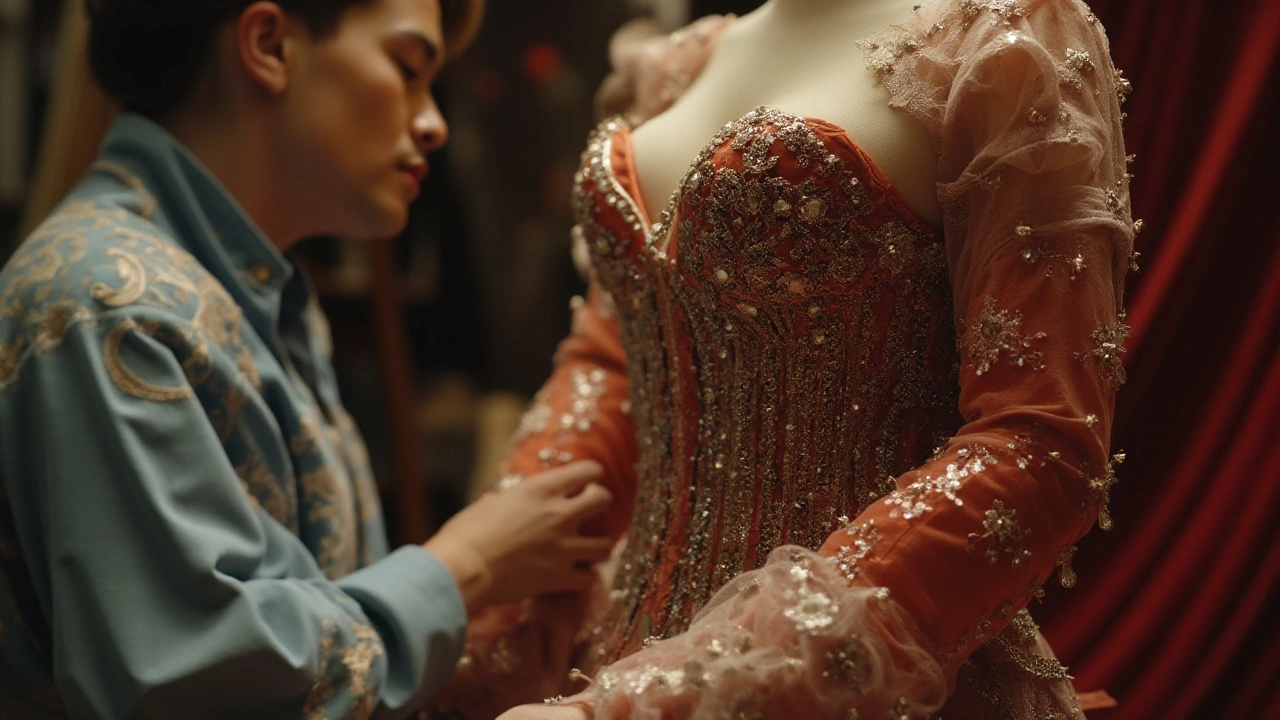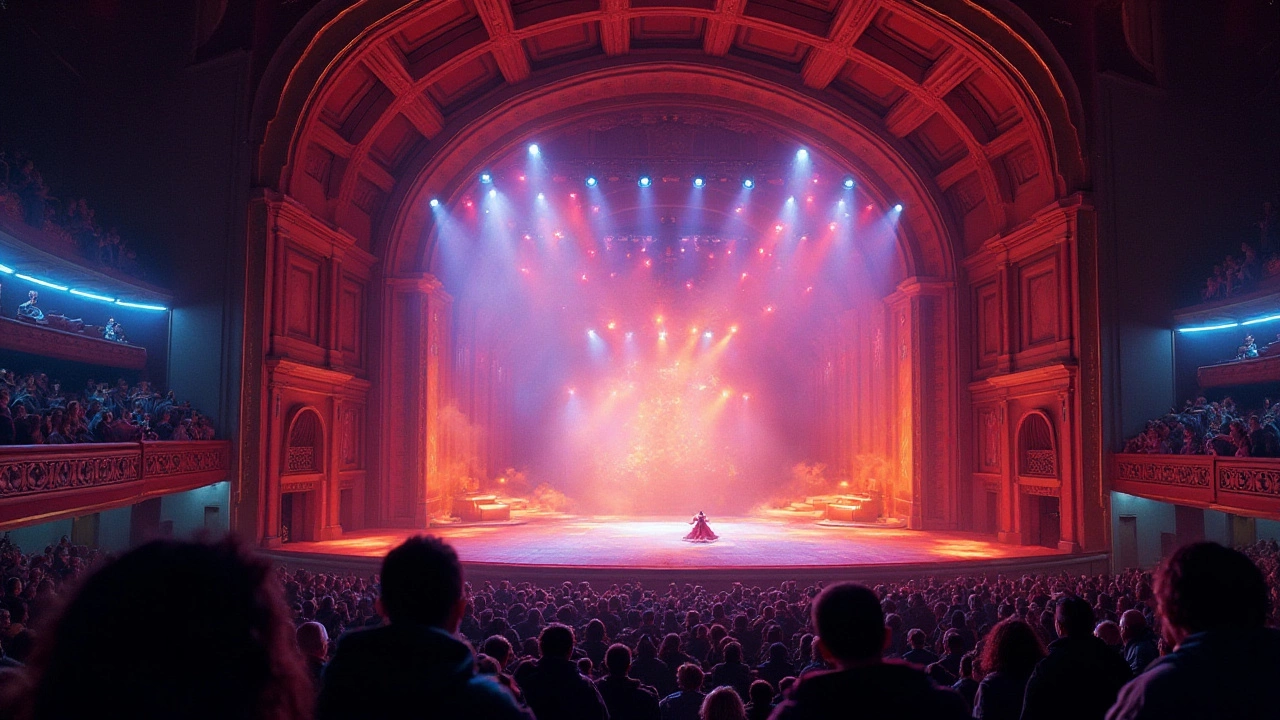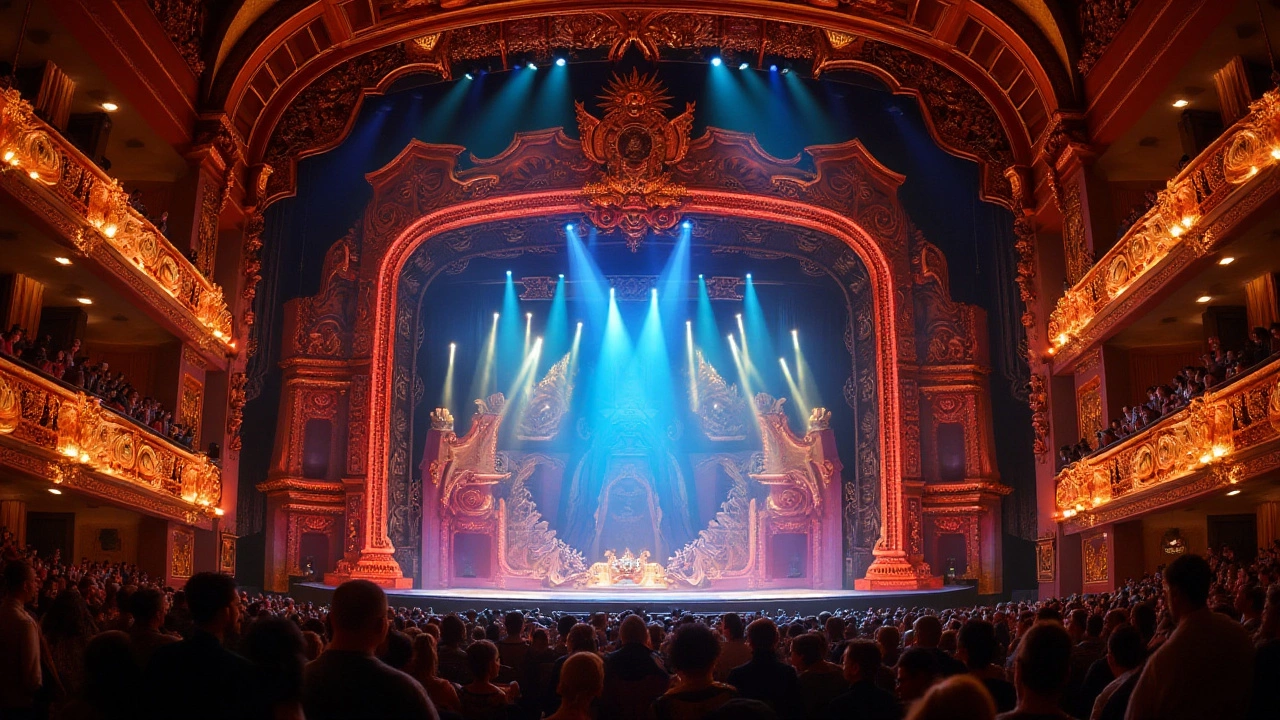When it comes to theatre, musicals can be some of the most spectacular and costly productions around. But what exactly makes a musical the most expensive of the lot? It's not just glittering lights and catchy tunes. There are the monumental sets, costumes that make you gasp, and technology that brings stories to life in ways we never imagined. Add in the long hours, immense talent, and hundreds of people working behind the scenes, and it's easy to see how costs can mount up significantly.
Join us as we take a journey through history to uncover the most expensive musical ever staged. We explore the factors that contribute to such grand budgets and examine how technology and creativity play a pivotal role in crafting unforgettable experiences that draw audiences time and time again. Whether you've been dazzled from the front row or dream of your curtain call, there's much to learn about what goes into creating the masterpieces that command not only the stage but also premium price tags.
- Understanding Production Costs
- The Biggest Budget Musicals
- Tech and Innovation in Expensive Musicals
- The Alluring World of Stage Craft
- Audience Reactions and Legacy
Understanding Production Costs
Many people marvel at the majesty of a grand stage, not fully realizing what goes into bringing a breathtaking musical to life. Let's pull back the curtain and delve into what truly comprises production costs in the world of musical theatre. At the heart of any production is its script and score, but to translate these elements into a full-scale performance requires an orchestra of decision-making and expenditure. The initial costs often start with acquiring the rights to top-notch stories or music, which can sometimes reach exorbitant figures, especially if the source material is beloved or high-profile. Once rights are secured, directors, composers, and choreographers are typically next on the list, commanding substantial fees for their creative genius, with their reputations often dictating the scale of a show's success long before opening night.
As the vision crystallizes, the construction of elaborate sets and the creation of stunning costumes soon follow suit. These aren't makeshift affairs; each set piece and garment must withstand repeated performances while continually captivating audiences. Designers and craftspeople dedicate months to perfecting every detail, using premium materials to ensure durability and allure. This level of detail extends to lighting and sound design, both integral to ensuring that each musical number transcends the ordinary. State-of-the-art sound systems and dynamic lighting rigs aren't optional extras—they're essential investments that can elevate performances to such great heights that audiences are mesmerized.
"It is not enough to have a great lead performer," noted a seasoned Broadway producer. "Every aspect has to be a powerful statement, from the frames that hang invisibly in the background to the glimmers of sequins onstage."
Rehearsals are another crucial component, as performers spend countless hours perfecting their craft. Don't forget, every day spent rehearsing incurs expenses like pay for a large cast and crew, rented spaces, and sometimes even transportation. And as the premiere looms, the marketing machine gets into high gear, consuming a considerable chunk of the budget. From billboard advertising to digital campaigns, ensuring that a musical makes a splash is crucial, and the costs here are often underestimated. As ticket sales must compete with countless other entertainment options, a gripping marketing strategy is just as important as the show itself.
Now, let's talk about ongoing expenses that might not be immediately apparent. From royalties to insurance, running costs to potential unforeseen repairs—these are the hidden facets of keeping a musical production afloat. Even seemingly smaller elements, such as the quality of refreshments or the aesthetics of the theater, contribute to the holistic experience and are factored into the financial equation. Understanding these components provides deeper insight into why some musicals require such immense financial backing, making each stunning performance both an artistic triumph and a calculated gamble.
The Biggest Budget Musicals
When it comes to spending big, Broadway is no stranger to running up astronomical bills. At the top of the list sits Spider-Man: Turn Off the Dark, notorious not just for its price tag but for its tumultuous journey. With a budget that soared over $75 million, it is often talked about in whispers and wonder. The costs were driven largely by the extravagant sets and special effects, techniques that meld theatre and technological wonder into a high-flying spectacle. Creators aimed to bring the comic book world to life with the use of remarkable aerial stunts and innovative stagecraft, a feat that entailed endless expenses.
Another heavyweight contender on Broadway's list is The Lion King, adored for its spellbinding costumes and stunning puppetry. It's the creative genius of Julie Taymor that transforms this beloved Disney narrative into a live theatre epic. Each costume is art in itself, thoroughly researched and exquisitely constructed, contributing to the significant investment required for its success. The musical, however, has reaped the rewards of its ingenuity, consistently drawing packed houses worldwide.
Next, we have the sweeping grandeur of Wicked. Spectators are often amazed by the intricate details of the Emerald City and the sheer magic weaved throughout. Allegedly, this green-hued musical came with a budget close to $14 million when it initially opened. The impact of this expense, however, glows on stage with each note, whether in the form of dazzling emerald designs or complex character-driven dialogues. Its financial performance matches its critical acclaim, evident in its enduring appeal and strong box office figures.
Les Misérables is yet another spectacle that merits mention whenever high-budget musicals are discussed. When it debuted, its budget was a staggering sum, around $4.5 million for a full-scale production. This adaptation of Victor Hugo's epic tale involves grandiose sets and hundreds of lavish costumes, creating a cinematic scale unparalleled in theatre at the time. The show's crafty amalgamation of humanity and history broke new ground in storytelling, establishing a new benchmark for musical innovation. Even today, it continues to inspire producers to think grand while staying true to storytelling.
Table:
| Musical | Original Budget |
|---|---|
| Spider-Man: Turn Off the Dark | $75 million |
| The Lion King | Est. $20 million |
| Wicked | $14 million |
| Les Misérables | $4.5 million |

Tech and Innovation in Expensive Musicals
The world of musical theatre is one of magic and wonder, much of which stems from the seamless integration of technology into stagecraft. Innovations have transformed how stories are told, allowing audiences to experience new dimensions of storytelling. Nowadays, some of the most breathtaking moments in theatre are achieved through technological feats that not only entertain but virtually transport viewers into the narrative. A fantastic example is seen in the musical 'The Lord of the Rings,' where advanced projection technologies transform stages into sweeping landscapes, bringing Tolkien's epic world vividly to life.
Broadway's 'The Lion King' is a testament to how tech can elevate a show's grandeur. Combining life-sized puppetry with traditional stagecraft, the musical uses intricate mechanics to create the seamless fluidity of motion across a savannah. Another noteworthy example is 'Spider-Man: Turn Off the Dark,' a production infamous for its ambitious use of aerial choreography. Though it encountered significant hurdles, it demonstrated the potential of using sophisticated rigging systems to bring the dynamic movements of Spider-Man to the stage, akin to a scene from a Hollywood blockbuster.
Lighting and Sound Innovations
A significant component of these expensive musicals is the incredible lighting and sound design. By harnessing cutting-edge digital soundscapes and customized lighting systems, productions can evoke mood and emotion in ways previously unimaginable. The musical 'Hamilton,' for instance, uses an intricate light grid and powerful acoustics to enhance the historical narrative with a contemporary edge. This seamless integration allows actors' performances to shine, while effectively encapsulating audiences in the heat of revolutionary fervor. Curious minds often ponder on how lighting can capture the essence of the era, but few realize the painstaking precision involved in its execution.
To illustrate the impact of sound innovations, one might consider the iconic 'Phantom of the Opera,' which employs a surround sound system that envelops the audience, making the music a visceral experience. The enveloping sound helps create moments of intimacy and tension, amplifying the emotional impact of each scene. According to a respected theatre critic, "The direction in which theatre is heading is no longer linear, thanks to technology. It can take you from the peak of the emotional spectrum to the valley within moments."
Beyond the Stage: Interactive Experiences
While technology has undoubtedly enhanced what's possible on stage, it has also revolutionized the audience's engagement through immersive technologies. Productions are increasingly experimenting with augmented reality (AR) and virtual reality (VR) elements to deepen fan engagement. Some shows have started integrating AR within their promotional shows or offering VR experiences to fans who can't make it to the theatre. These technologies allow audiences to step into their favorite scenes and interact with characters in ways that were once pure flights of fantasy. What was once seen as futuristic is now at the core of redefining theatrical experiences.
Another development is the use of smart apps, which unite theatre-goers in conversation, spark debates, and foster community, even after the curtain falls. Whether it's through a backstage featurette or an interactive forum, musicals are building expansive worlds for audiences to explore and enjoy. According to some industry observers, these innovations mark just the start of a new era of entertainment, drawing more people into the world of theatre and expanding its reach far beyond traditional parameters.
The Alluring World of Stage Craft
The stage is where dreams meet reality, wrapped in a symphony of lights, sound, and color, creating the magic we know as theatre. In musicals, this magic is magnified tenfold by the enchanting art of stage craft. Drawing on traditions that go back centuries, modern stagecraft weaves a visual narrative that aligns with the story’s rhythm, enhancing the viewer’s experience beyond words. It’s an intricate blend of artistry, engineering, and sometimes even trickery, requiring the precise choreography of immense backdrops, whimsical props, and dazzling lighting that dances along with the performers to tell a story quite unlike any other.
This theatrical alchemy often involves cutting-edge technology that continually pushes the boundaries of what's possible. Take, for example, the spectacle that is Broadway's 'The Lion King'. This production, renowned for its breathtaking visuals, proves how stagecraft can elevate a story to dreamy new heights. The ingenious use of puppetry and elaborate costume design brings to life the stunning African landscape and its vibrant animal kingdom. Such creativity has its roots in the meticulous replication of cultures and a deep respect for authenticity, combining storytelling with a bold visual representation that takes audiences on a journey akin to magic. This isn't just imagination running wild; it's a disciplined synthesis of craftsmanship and technology.
Intriguingly, the most expansive musicals may house entire operations behind the curtains, functioning like clockwork to ensure seamless transitions. Set pieces, which can weigh thousands of pounds, are designed meticulously, often requiring weeks of planning and construction before making their grand entrance on the stage. 'Miss Saigon', another milestone in theatre history, is famed for its staggering helicopter scene—an example of engineering excellence that etched its embodiment of realism into the hearts of many. Capturing moments like these involves significant effort, from harnessing mechanical advancements to employing materials that mimic reality while being lightweight enough for rapid changeovers during performances. Embedding these elements in the fabric of the performance crafts a visceral experience that words alone cannot capture.
The world of stage craft embraces tradition as much as it does innovation, and this balance offers audiences the very best of theatrical experiences. Musical theatre enthusiasts will often recollect how the grandiosity of 'Les Misérables' reframed their understanding of what stagecraft could achieve. Its revolutionary barricades set the scene for dramatic tension and perseverance in the fight for freedom, ranging seamlessly through innovative uses of space and structure. The allure of stagecraft lies in its ceaseless ability to adapt, to rethink conventional paradigms, and in doing so, to create breathtaking tales told through space and movement.
Alongside these visual feastings, there’s a quiet acknowledgment of the myriad skills behind the stunning assembly. Stage designers, lighting architects, sound engineers, and craftsmen all play crucial roles, their unseen hands the magicians behind the scenes. Productions such as 'Phantom of the Opera' have transformed their stage into mesmerizing spectacles, marrying profound acoustics with haunting set designs that have captivated millions worldwide. Their collective talent crafts the allure of the theatre—an allure so potent that expensive musicals are not merely viewed as a luxurious indulgence but revered as an art form that stirs the soul. Reflecting on theatre’s transformative power, Thomas Schumacher, president of Disney Theatrical Productions, beautifully captured this essence when he said,
"The journey of creating theatre is a blend of chaos and beauty, teaching us empathy in every direction."
This ceaseless dedication to craft and innovation ensures that the future of theatre remains bright. In the land of dreams and spectacle, nothing exemplifies this more than the continued commitment to produce shows that dazzle and inspire with every performance—a testament to the soulful allure of stage craft.

Audience Reactions and Legacy
The most expensive musicals are not only hefty in their budgets, but they also leave an indelible mark on audiences across the globe. One of the wonders of these grand productions is the myriad of reactions they evoke from the viewers, ranging from awe to inspiration. When a musical has an immense budget, audiences walk into the theatre with high expectations; the promise of dazzling effects, lavish costumes, and orchestrations that wrap around the heart is palpable. Take, for instance, reactions to ‘Spider-Man: Turn Off the Dark.’ Initially infamous for its staggering expenses and technical hitches, it eventually earned a place in theatre lore, prompting varied responses from the enthusiastic viewers who embraced its innovations despite mixed reviews.
Legacy, in the world of theatre, is carved in the memories of the viewers and reflected in the stories that are passed down about a production. The sheer scale of these expensive shows means that they are frequently talked-about years, even decades, after their premieres. Consider 'The Lion King': not just a show, but an experience that has enthralled millions since its debut. With its estimated production costs leading the Broadway charts, its legacy is rich—blending captivating storytelling with inventive stagecraft. Its influence can be seen in how other productions have incorporated elements of puppetry and unique scenic design that push the boundaries of what is traditionally expected in musical theatre.
Audience reactions are cataloged through reviews, word of mouth, and increasingly, social media, where theatre lovers can share their experiences instantaneously. The modern spread of reactions and opinions can further bolster a show's legacy, as more people are encouraged to experience the spectacle themselves and add their voices to the chorus of feedback. As TIME Magazine pointed out, there's a magical alchemy in musicals where the audience becomes an integral part of the creation.
“But there’s still nothing like the feeling of hearing an audience gasp in unison at a moment of unexpected beauty.”This communal experience is a cornerstone of why such musicals maintain a legacy that lasts far beyond their original runs.
The legacy of these productions is also reflective in the talent they showcase. Stay long enough in theatre circles, and you'll hear tales of actors who were catapulted into stardom through roles in these costly shows. The blend of unmatchable talent on stage and incredible resources results in performances that touch the soul and linger long after the curtains have fallen. Often these legacies are immortalized through recordings, merchandise, and the stories shared among theatre enthusiasts who experienced the magic first-hand. In short, the impact of these impressive and financially colossal feats go beyond numbers, weaving into the cultural tapestry, making musical theatre a gift to cherish through time.

